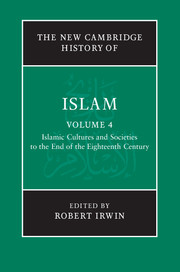Book contents
- Frontmatter
- Introduction
- PART I RELIGION AND LAW
- PART II SOCIETIES, POLITICS AND ECONOMICS
- PART III LITERATURE
- PART IV LEARNING, ARTS AND CULTURE
- 20 Education
- 21 Philosophy
- 22 The sciences in Islamic societies (750–1800)
- 23 Occult sciences and medicine
- 24 Literary and oral cultures
- 25 Islamic art and architecture
- 26 Music
- 27 Cookery
- Glossary
- Bibliography
- Index
- References
23 - Occult sciences and medicine
from PART IV - LEARNING, ARTS AND CULTURE
Published online by Cambridge University Press: 28 March 2011
- Frontmatter
- Introduction
- PART I RELIGION AND LAW
- PART II SOCIETIES, POLITICS AND ECONOMICS
- PART III LITERATURE
- PART IV LEARNING, ARTS AND CULTURE
- 20 Education
- 21 Philosophy
- 22 The sciences in Islamic societies (750–1800)
- 23 Occult sciences and medicine
- 24 Literary and oral cultures
- 25 Islamic art and architecture
- 26 Music
- 27 Cookery
- Glossary
- Bibliography
- Index
- References
Summary
In his Muqaddima (Prolegomena) the well-known sage Ibn Khaldūn (d. 808/1406) reported a diversity of opinion among Muslim jurists concerning the grounds for the imposition of the death penalty upon practitioners of magic. The term he employed here is siḥr, an appellation which denotes a very wide range of occult phenomena; it is generally rendered by scholars as ‘magic’ or ‘sorcery’ in the generic sense, the two words often used interchangeably. Ibn Khaldūn’s account constitutes one of the two classic discourses on occult sciences in medieval Islam, and his report is, typically, of a very high historical and sociological value. For example, one notes that it throws into relief what are the two fundamental features of the approach to siḥr in the Islamic milieu. One is the sustained belief in the reality of siḥr – that it is ḥaqq (true/real); the second, a legal determination of its reprehensibility – that the practice of siḥr is a contravention of the articulated body of divine law. But all of this needs to be qualified and elaborated.
In the chapter ‘On the sciences of siḥr and ṭilasmāt’ Ibn Khaldūn wrote of three degrees of the souls that have magical ability (al-nufūs al-sāḥira). To the first degree belong those that carry out their influence upon the world of corporeal elements, or upon other souls, through their own endeavour (himma) alone, without any external instrument or aid.
- Type
- Chapter
- Information
- The New Cambridge History of Islam , pp. 640 - 667Publisher: Cambridge University PressPrint publication year: 2010



